Samaaro + Your CRM: Zero Integration Fee for Annual Sign-Ups Until 30 June, 2025
- 00Days
- 00Hrs
- 00Min
In today’s rapidly evolving world, the traditional concept of exhibitions has been redefined through the power of technology. Virtual exhibitions have evolved as a novel and game-changing alternative for event organisers and company owners looking to reach a worldwide audience while overcoming the restrictions of real events.
In this in-depth study, we will delve into the concept of virtual exhibitions and explore the plethora of capabilities they offer to revolutionise the way events are organised and experienced.
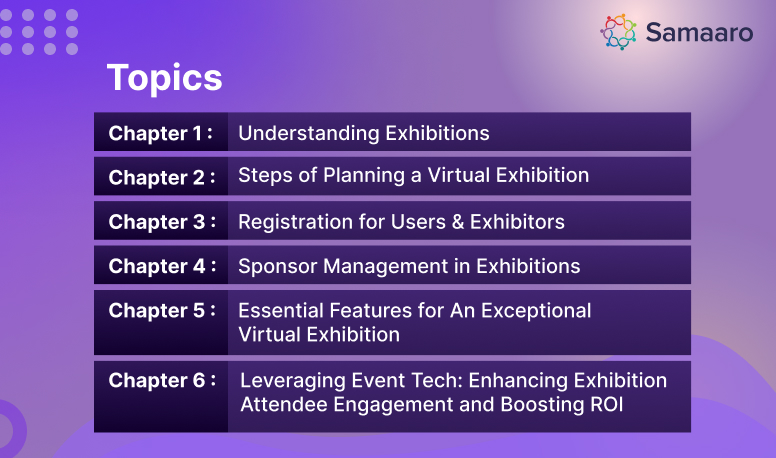
A virtual exhibition is an entirely digital event that simulates the experience of a real exhibition via an online platform. It allows exhibitors to present their products or services, interact with visitors, and network with potential collaborators or clients from all over the world, breaking the barriers of time and space.
Virtual shows provide several advantages over traditional exhibitions. They are more affordable and give a more convenient platform for both customers and brands. Virtual exhibits have arisen as an extremely dependable method of networking, building community ties, and successfully exhibiting a company’s narrative.
Virtual exhibits have significant benefits over traditional physical exhibitions, making them a valuable tool for displaying content and engaging people.
Global Accessibility: One of the most major advantages of virtual exhibits is that they can be accessed from anywhere in the globe by anybody with an internet connection. This worldwide accessibility broadens the exhibition’s reach to a considerably bigger audience than a physical event would, allowing individuals from other nations and regions to participate without having to travel.
Enhanced Interactivity: Interactive components like as 3D models, multimedia presentations, audio tours, and clickable material can be included in virtual exhibitions to improve the visitor experience and make it more engaging and instructive.
Timeless Access: Due to space limits and scheduling, physical displays have a limited lifespan. Virtual exhibits may be kept online for a long time, allowing viewers to access and review the content whenever they plan.
Analytics and Insights: Digital platforms offer useful insights into visitor behaviour and preferences. Organisers can collect statistics on the number of visitors, popular displays, time spent on each item, and other factors to help with future planning and increasing the exhibition’s effect.
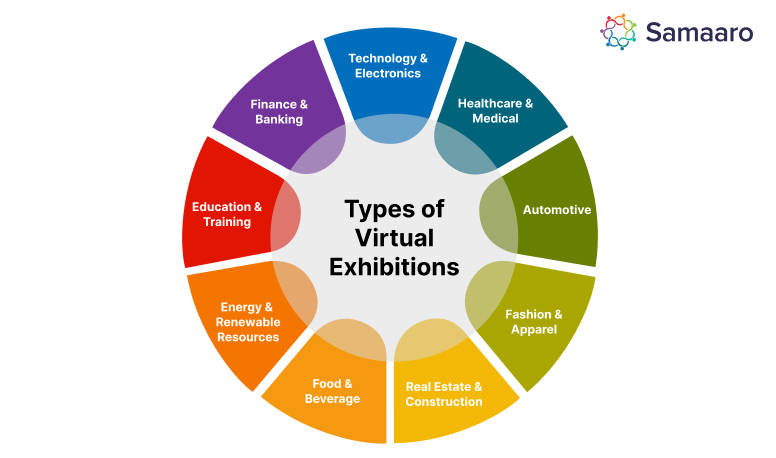
Virtual exhibitions have emerged as powerful alternatives to physical gatherings, offering diverse benefits like global accessibility, cost-effectiveness, and flexibility. Each type of virtual exhibition caters to specific interests and industries, fostering networking, knowledge exchange, and community engagement in the digital age.
Technology and Electronics: Virtual exhibitions in this field showcase the latest innovations in gadgets, software, and consumer electronics, allowing participants to interact with cutting-edge technologies from the comfort of their own homes and explore virtual showrooms for a hands-on experience.
Healthcare and Medical: Virtual exhibitions in healthcare and medical domains serve as platforms to present advancements in medical equipment, pharmaceuticals, and telemedicine solutions. Participants can engage in live webinars, virtual demos, and networking opportunities to stay informed about the latest developments in the industry.
Automotive: Virtual automotive exhibitions offer car enthusiasts and industry professionals a digital space to explore the latest car models, concept designs, and automotive technologies. Attendees can view 3D models, participate in virtual test drives, and attend product launches, all without leaving their homes.
Fashion and Apparel: In virtual fashion exhibitions, designers can showcase their latest collections through high-resolution virtual runways, enabling fashion enthusiasts and buyers worldwide to attend fashion shows, explore new trends, and interact with virtual showrooms to place orders and gain insights into the industry.
Real Estate and Construction: Virtual exhibitions in real estate and construction offer a 3D immersive experience for property developers, buyers, and investors. Attendees can virtually tour properties, explore architectural designs, and attend seminars on the latest trends and technologies shaping the industry.
Food and Beverage: Virtual exhibitions in the food and beverage industry provide a digital platform for food vendors, manufacturers, and restaurateurs to showcase their products, offer virtual tastings, and engage in B2B networking to foster new business partnerships.
Energy and Renewable Resources: Virtual exhibitions in this field present the latest advancements in renewable energy technologies, sustainable practices, and energy-efficient solutions. Participants can attend webinars, explore interactive displays, and connect with industry experts to promote eco-friendly practices.
Education and Training: Virtual exhibitions in education and training focus on e-learning platforms, digital learning tools, and educational resources. Educators, students, and institutions can participate in virtual classrooms, demo educational technologies, and discuss the future of online education.
Finance and Banking: Virtual exhibitions in finance and banking offer a platform for financial institutions, fintech companies, and investors to showcase their services, hold webinars on financial literacy, and engage in discussions about the evolving landscape of the financial sector.
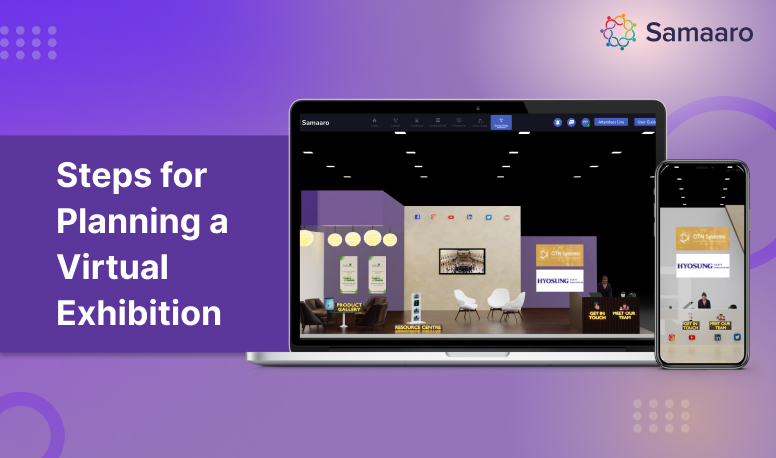
To ensure the success and engagement of a virtual exhibition, numerous things must be carefully considered. Here is a step-by-step approach to organising a virtual exhibition:
Specify Goals: Begin by identifying explicitly stated goals for your virtual exhibition. Understand your objectives for the event. Among the objectives might include raising brand awareness, generating leads, educating participants, or establishing collaborations. Having well-defined objectives will assist guide the planning process and assess the success of the event.
Create an Event Plan Strategy: Create an event plan strategy that covers the full process, from pre-event promotion to post-event follow-up. Include important milestones, deadlines, roles and duties, and marketing techniques to entice attendees. This strategy should also include content development, speaker selection, and sponsorship options. Below are some example questions that should be addressed while organizing an online exhibition:
Selecting the Right Event Tech Platform: Choosing the right virtual event platform is critical for a successful exhibition. Consider elements like as usability, interaction, scalability, and audience reach. Look for solutions that can host webinars, live streaming, virtual booths, and networking places. Test the platform properly to verify that it suits your needs.
Make the Exhibition Interactive with Amazing Features: Engagement is critical for the success of a virtual exhibition. Include interactive elements such as product finder, search & filter options, scavenger hunts to boost interaction. Make it possible for attendees to communicate with exhibitors via chat or video calls. To improve the experience, consider incorporating 3D virtual booths with product demos and swag bags.
Gather Feedback: Attendee satisfaction and areas for development may be greatly improved by gathering feedback. Collect input from participants via surveys or polls both during and after the virtual display. Inquire about their overall experience, favourite aspects, and any future event recommendations. Utilise this input to improve future exhibits.
Track event analytics to acquire insights into attendee behaviour, content performance, and overall event success. Keep track of KPIs like the number of registrants, session attendance rates, engagement levels, and lead conversion rates. This information will be used to assess the event’s impact and give vital insights for future planning.

Registration for users and exhibitors is a crucial aspect of virtual exhibitions. For users, the process focuses on creating a seamless and personalized experience, while exhibitors go through a more involved process to showcase their offerings effectively.
With proper registration and preparation, virtual exhibitions can be highly successful in connecting businesses and individuals across the globe.
The first step that potential attendees must do to participate in a virtual exhibition is to register as a user. The registration procedure varies according on the platform hosting the event, but it usually consists of the following steps:
Landing Page: The website for the virtual exhibition will have a landing page with information about the event, its schedule, and major attractions. Users will be able to begin the registration process by clicking a visible “Register” or “Sign Up” button on the website.
Personal Information: Users will be routed to a registration form where they must submit personal information such as their name, email address, and, in certain cases, a phone number. This data is essential for event organisers to engage with participants and offer event-related updates.
Establish a Profile: Some virtual exhibition platforms allow users to establish personalised profiles that include professional information, interests, and social network handles. This facilitates networking and helps exhibitors to better understand their target demographic.
Ticket Selection: Virtual exhibits may ask consumers to pick a ticket type depending on their preferences in some situations. For example, various ticket categories might have differing degrees of access or additional privileges.
Payment: While many virtual exhibits are free to visit, others may charge a registration fee to support event costs. Users will be requested to make a safe payment using the site.
Confirmation and Access Details: After completing the registration procedure, users will get an email with their access details, event links, and any additional instructions they may need to join the virtual exhibition.
Organization Information: During the application process, exhibitors will be asked to provide details about their company or organization, including name, description, logo, and contact information.
Select Exhibition Booth: Virtual exhibitions often offer different booth with varying levels of visibility and features. Exhibitors will choose a package that aligns with their marketing goals and budget.
Booth Customization: Exhibitors can customize their virtual booth using the dashboard. They can upload branding elements such as logos, banners, and booth designs to create a visually appealing and on-brand representation of their company.
Dashboard: The dashboard provides exhibitors with real-time analytics about visitor engagement. They can see the number of visitors, the duration of their visits, popular booth sections, and more. This data helps exhibitors understand their audience and make informed decisions. It allows to capture and manage leads generated during the virtual exhibition. They can view contact information of potential customers and export the data for further follow-up.
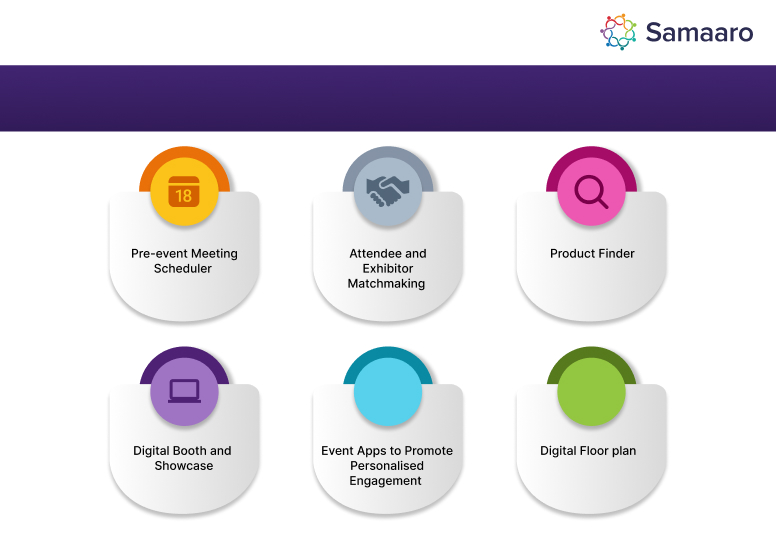
Pre-event Meeting Scheduler
A pre-event meeting scheduler is a tool that allows attendees and exhibitors to schedule meetings before the virtual show begins. It allows participants to organise their calendars ahead of time and maximises networking chances.
Attendees can explore the list of exhibitors and their profiles, see their products/services, and then request appointments with certain exhibitors during specific time windows. Likewise, exhibitors may contact potential leads and set up appointments with interested attendees. This feature simplifies the process of interacting with relevant individuals and guarantees that important interactions do not go unnoticed during the virtual event.
Attendee and Exhibitor Matchmaking
The tool uses AI algorithms to link attendees with exhibitors based on their preferences, interests, and business objectives. Attendees may be expected to fill up a thorough profile showcasing their industry, interests, goods of interest, and so on when they register for the virtual expo.
Exhibitors, meanwhile, submit information about their services, target audience, and business objectives. This data is then analysed by the AI-powered matching engine, which suggests appropriate exhibitors to attendees and vice versa. This guarantees that guests are linked with the most appropriate exhibitors, which improves their entire experience and increases the possibility of fruitful connections.
Product Finder
Matchmaking is just a simplified way of connecting the participants with relevant exhibitors. To further improve the experience for the attendees, consider a platform that offers a tool that enables attendees to quickly search for products & sellers that they wish to explore.
Digital Booth & Showcase
The digital booth and showcase are virtual representations of an exhibitor’s actual display at the event. It is a customised online platform where exhibitors may showcase their products, services, promotional materials, and corporate information. To successfully engage guests, the digital booth frequently contains multimedia features including as movies, photos, brochures, and interactive demos.
Exhibitors may use the digital booth to present their services, communicate with visitors via live chat or video conferencing, and generate leads in a virtual setting. Attendees may tour various digital booths at their leisure, obtain information, and engage in real-time dialogues with exhibitors without having to physically present themselves.
Event Apps to Promote Personalised Engagement
Event applications have evolved into significant tools for interacting with participants in real time. Event applications keep attendees informed and involved during the event by using push alerts, personalised agendas, and interactive elements.
Organisers may send personalised messages to attendees, propose services based on their interests, and encourage networking opportunities, resulting in a more rewarding and personalised experience.
Digital Floor plan
A floor plan is a digital depiction of the virtual exhibition venue that shows how booths, stages, networking spaces, and other event features are laid out. It acts as a navigation tool for spectators to quickly navigate the virtual exhibition.
The floor design includes an interactive map that allows participants to view exhibitor information, join seminars, and engage in other activities by clicking on certain booths or regions. It assists guests in planning their event experience, locating relevant exhibitors, and identifying the schedule of talks or presentations they wish to attend. The floor layout improves the entire event experience by organising and making it more accessible to all participants.
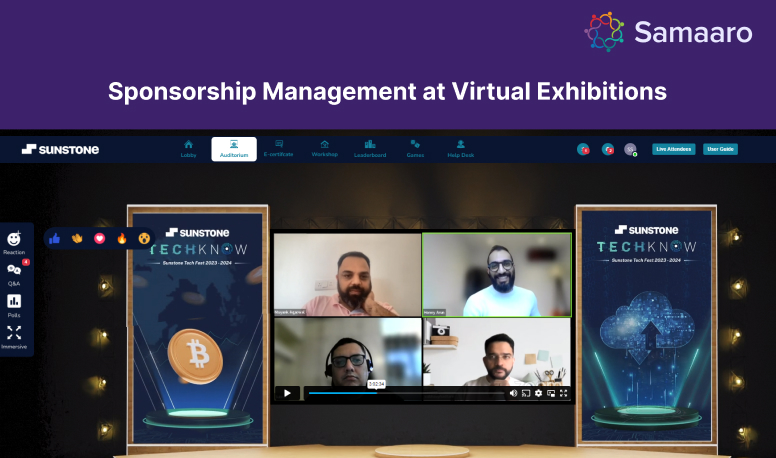
Organisations or people that support an event financially or in-kind in exchange for different perks are known as sponsors. A successful and gratifying collaboration for both the sponsors and the exhibitors depends on proper sponsorship management.
Documentation:
Sponsor management also involves creating and executing comprehensive plans for sponsors’ involvement during the event.
By effectively managing sponsors, exhibitors can build strong relationships, deliver on promises, and create a positive experience that encourages sponsors to participate in future events, leading to a successful and sustainable event ecosystem.
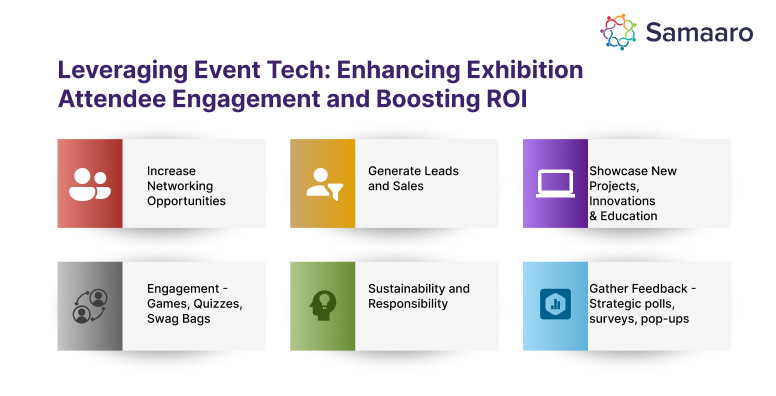
Increase Networking Opportunities (AI matchmaking, one-one/group chat & video calls)
Through AI matchmaking algorithms that join people based on their interests, industries, and preferences, event tech facilitates effortless networking. Participants can have meaningful conversations and create enduring relationships by meeting other like-minded professionals.
Additionally, one-on-one and group chat features offer in-the-moment conversations, enabling participants to share ideas, work together on projects, and talk about new business partnerships. By allowing face-to-face talks even in a virtual context, the integration of video call capabilities further increases the physical touch.
Generate Leads and Sales (virtual booths)
Exhibitors can create interactive and immersive digital booths, complete with product demonstrations, promotional videos, and downloadable resources. Attendees can access these booths at their convenience, facilitating a steady stream of leads throughout the event and beyond.
Organisers can track which sessions were the most popular, which booths had the most footfall, and which components of the event were the most popular with guests. Event organisers can take data-driven decisions to better future events, allocate resources, and ultimately boost ROI by analysing this data.
Showcase New Projects and Innovations & Education (conferencing)
Conferencing tools integrated with event technology platforms provide educational sessions and presentations where business leaders may discuss their latest projects and discoveries. In addition to fostering thought leadership and a culture of continual learning inside the exhibition space, these seminars offer insightful information.
Attendees are more likely to stay interested during the event by providing a wide variety of instructional information, which improves the whole event. Additionally, taped sessions may be made accessible for on-demand access, expanding the reach of the event past its scheduled duration.
Engagement – Games, Quizzes, Swag Bags
Event tech platforms can incorporate gamified elements like interactive games, quizzes, and competitions to keep attendees actively involved. This stimulates healthy competition, encourages guests to explore all exhibition areas, and increases the amount of time attendees spend interacting with exhibitors. Therefore, exhibitors benefit from more visibility, while attendees have a more engaging and collaborative event experience.
Sustainability and Responsibility
Event organizers and attendees are growing more aware of their environmental effect. By lowering the demand for physical resources and lowering the carbon footprint connected with conventional events, event technology may aid in sustainability initiatives. With virtual exhibits, less paper and other resources are used, and the accompanying travel for visitors may be minimised or avoided.
Gather Feedback – Strategic polls, surveys, pop-ups
For organisers and exhibitors, feedback is a significant asset for understanding visitor preferences, assessing event performance, and identifying areas for development. Strategic polls, surveys, and pop-ups strategically positioned around the event may capture real-time input from guests using event tech platforms. The information gathered can provide useful insights on attendee satisfaction, preferences, and pain points. Organisers may constantly improve their event plans and create more engaging and rewarding experiences for future guests by acting on this input.
Event registrations play a pivotal role in the success of any endeavour, whether it’s a corporate conference, a charitable fundraiser, or a community workshop. Getting registrants to the event quickly and efficiently is the first step towards making it successful and well-attended. A comprehensive and varying strategy is needed to grab the attention of prospective participants and persuade them to register. As a result of the growth of digital technology and the changing nature of event planning, organisers now have a wide range of resources at their disposal to increase registration rates. By using these strategies, you can make sure that your events not only draw a sizable audience but also generate buzz that creates the perfect setting for an amazing experience.

Choosing the most effective event registration and ticketing platform is the first step in quickly increasing event registrations.
By streamlining the registration procedure and making it user-friendly for participants while giving organisers crucial resources, a dependable Samaaro can assist you.
Here are a few significant considerations to bear in mind while selecting the best platform:
User Experience: Select a platform that provides a smooth user experience. Without needless obstacles or misunderstanding, attendees should be able to register and buy tickets swiftly and simply.
Multiple Payment Options: When it comes to payment options, people have a wide range of preferences. To appeal to a larger audience, offer a variety of payment methods, such as credit/debit cards, mobile wallets, and even offline purchases.
Branding and Customization: Make your event page unique to represent your branding and the spirit of the event. Potential attendees are given a professional impression and feel confident by visiting a website with strong branding.
Data Management and Analytics: Data tracking tools should be available on a robust platform. This enables you to keep track of the quantity of registrations, the demographics of attendees, and other useful information, assisting you in making data-driven decisions.
Marketing Tools: Search for platforms that integrate marketing tools such as social media platforms and email marketing software. As a result, you may advertise to a bigger audience and reach a wider audience and promote your event effectively.
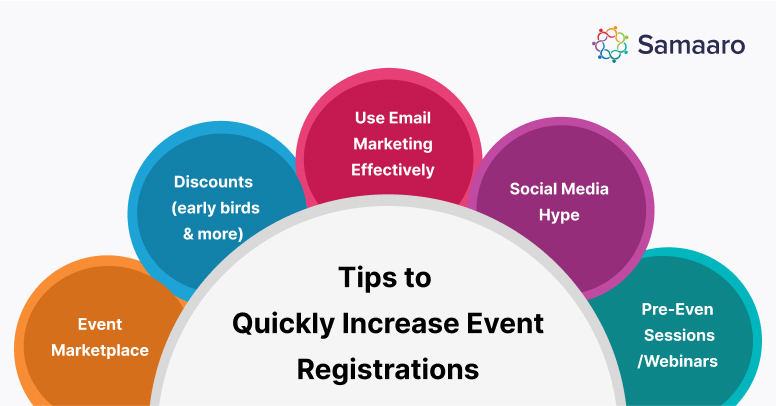
A. Event Marketplace
One effective strategy for expanding the reach of your event is to use event marketplaces. These platforms ensure that your event reaches the appropriate people by offering powerful search and recommendation options in addition to exposure to a larger audience. Use pertinent keywords and appealing images to enhance your event description when advertising it on marketplaces. Encourage previous participants to post comments on these websites as well, since favourable ratings may enhance credibility and draw in new signups.
B. Discounts or Early Bird Passes
Everyone loves a good deal! Offering early registration discounts is a tried-and-true method to encourage early registration. Don’t, however, limit yourself to a single promotion. Use a variety of promotional techniques to appeal to distinct target audience subgroups. To entice youthful participation, you may, for instance, give student discounts, group discounts for teams or coworkers, or bundle discounts for many events if you’re planning a series of related gatherings. Remember to effectively communicate these offers through all your marketing channels.
C. Email Marketing
According to a 2021 Markletic survey, 76% of marketers believe that using email marketing is the best way to generate event registrations. Organizers can additionally boost the return on investment for their event by putting into practise an excellent email marketing plan. To spread awareness, start by sending out a save-the-date email. Follow up with emails that are both instructive and persuading about the advantages and highlights of the event. Make sure your emails include distinct calls to action that take recipients straight to the registration page. Creating FOMO before the event can really help boost registrations. Incorporate countdown timers into your emails as well to evoke a feeling of urgency as the event date gets near. Furthermore, personalization may greatly increase conversion and open rates.
D. Social Media Hype
Social media is a treasure trove for promoting events and boosting registrations. Host live Q&A sessions or virtual meet-and-greet events with speakers or performers to foster a sense of community and anticipation around your gathering. Share teaser videos, behind-the-scenes snapshots, and guests’ reviews. Partnering with social media influencers or micro-influencers in your sector is something to think about. These influencers may spread the word about your event among their followers, exposing it to a larger and more pertinent audience. Run surveys, competitions, or freebies to keep your audience interested in your event.
E. Pre-Event Sessions
Webinars or pre-event seminars can have a variety of uses. Use these platforms to encourage participants to register for the main event. In addition to building anticipation, they give potential attendees helpful information that illustrates the benefits of attending the main event. Collaborate with prominent speakers or subject-matter experts to lead these sessions, making sure the subjects match the overall theme of the event or offer fresh perspectives on the subject. Gate these pre-event sessions with a free registration requirement to maximise the effect of registration. This not only compiles useful attendance data but also motivates attendees to successfully register for the main event. To increase the number of people who can attend your event, you should record these sessions and make them available as on-demand material.
Were you aware that, as stated in a recent Markeltic report, “87% of B2B companies experience a favourable return on investment from their hybrid events within 7 months of the event”? It is quite evident that hybrid events are assured to become the predominant form of events soon.
Hybrid events have emerged as a game-changer in the event industry. They provide a vibrant and welcoming platform for attendees and organizers that is not constrained by venue size or location. Whether it’s a conference, trade exhibition, concert, or business meeting, hybrid events break down traditional barriers to reach a larger audience. They enable scalability, inclusiveness, and cost-effectiveness by allowing attendees to participate in-person or remotely.
In past blogs, we have stressed on how organisers can save money on venue rents, lodging, food, and transport arrangements for both attendees and speakers. By incorporating virtual aspects, the event becomes more accessible and economical for remote attendees, removing the need for costly accommodations and transportation. This not only lowers costs but also allows smaller organisations or individuals to organise and participate in events that were previously beyond of reach.
Hybrid events are highly worthwhile because they provide a winning combination of sustainability, profitability, and accessibility. The future of events rests in the integration of hybrid experiences, where attendees will increasingly need extraordinary levels of personalisation and participation. This trend will see the seamless integration of online events with displaying in-person meetings, providing a dynamic and inclusive approach. Attendees may engage from anywhere in the globe by curating a varied assortment of virtual activities, overcoming geographical and temporal barriers.
But that’s not all. With a myriad of interactive tools, live streaming capabilities, and virtual networking platforms at their disposal, organizers can create engaging and immersive experiences for both in-person and online attendees. Hybrid events embrace this amalgamation of digital and physical elements, harnessing the best of both worlds to deliver an event that is both dynamic and memorable.
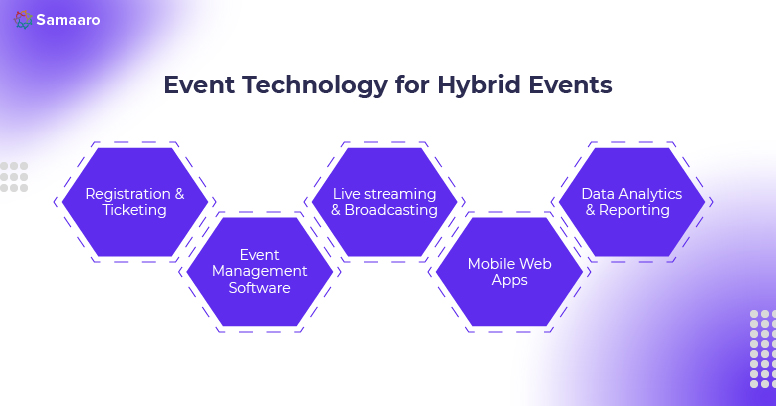
A. Registration & Ticketing
Streamlined registration and ticketing technologies streamline the attendance management process. Participants may quickly sign up for events, choose their preferred form of attendance, and make secure online payments. Samaaro also gives complete attendee data to organisers, allowing for personalized communication and effective logistical planning.
B. Event management software
EMS is an integral part of hybrid events, provides a comprehensive set of tools to simplify event planning and execution. Samaaro provides event organisers with the ability to create event websites, manage registrations, and deliver customised communications to participants. Event management software can provide flawless event operations through facilitating seamless session scheduling, speaker management, and exhibitor collaboration. Interactive technologies such as virtual networking areas, gamification elements, and attendee engagement measurements are also provided by event management software. Organisers may follow attendee behaviour, quantify event performance, and make data-driven decisions for future events with extensive analytics and reporting tools. From start to end, the all-in-one solution enables organisers to easily manage all element of their hybrid events.
C. Live Streaming & Broadcasting
The lifeline of hybrid events is live streaming and broadcasting technology, which bridges the gap between physical and virtual audiences. Remote participants may tune in and engage in real time via high-quality video streaming technologies. Virtual guests may interact with presenters and fellow attendees through interactive features like as live chat and Q&A sessions, establishing meaningful connections. Organisers can also incorporate photo booths for both virtual and in-person participants to create lasting memories of the event.
D. Mobile Web Apps
Mobile web apps improve engagement and involvement for both in-person and remote attendees. These applications include customized timetables, interactive maps, and session reminders. They also allow for seamless communication, allowing attendees to network, share contact information, and remain up to speed on event announcements. Mobile web applications ensure guests have access to all of the information they require, boosting their entire event experience. Not only participants, but also organisers, can gain access to a wealth of information via mobile web apps. Using surveys and polls, organisers may track participant activity, monitor session attendance, and gather feedback. Organisers can improve participant navigation and exhibitor exposure by using tools like as interactive maps and exhibitor catalogues.
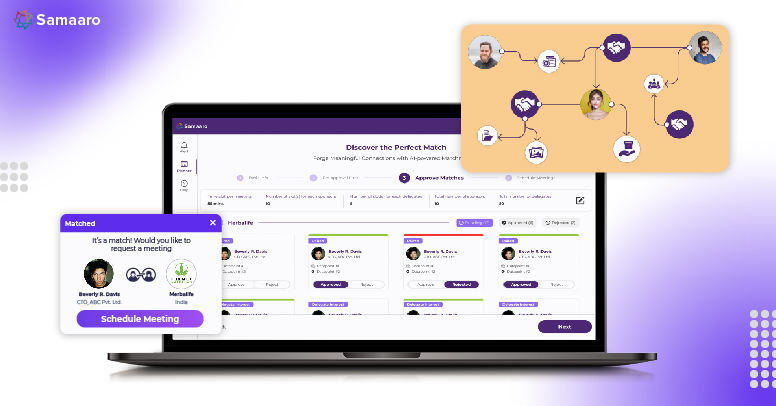
E. Networking
The combination of numerous digital tools and technology has substantially improved networking in hybrid events. AI matchmaking empowers participants to connect with relevant counterparts, optimising networking possibilities, and encouraging meaningful conversations. Furthermore, pre-event meeting schedulers enables attendees to arrange and organise meetings ahead of time, assuring time efficiency and focused involvement during the event. With the digitalization of business cards and connection requests, transferring contact information is now simple, allowing participants to easily grow their networks. Furthermore, live chat tools enable real-time contact between virtual and in-person participants, allowing for immediate interactions, information exchange, and collaboration, eventually improving the overall networking experience in hybrid events.
Organisers may build immersive and engaging experiences that cater to a varied audience by effectively utilising event technology. The combination of in-person interaction with remote accessibility opens new avenues for knowledge exchange, networking, and company expansion. As the event industry evolves, hybrid events and the technology that enable them will play a critical role in creating the future of event experiences. Whether you’re seeking a greener, more engaging, and future-forward event experience, embracing the power of hybrid events is the way to go. Get ready to revolutionize your events and unlock a world of possibilities with Samaaro!
When organizing events, one of the primary goals is to ensure high levels of attendee engagement. Engaged attendees are more likely to derive value from the event, actively participate in sessions, interact with fellow attendees, and provide positive feedback. This engagement not only enhances the overall event experience but also drives business outcomes such as networking, knowledge sharing, and potential partnerships.
One of the best ways of achieving attendee engagement is – Gamification. By leveraging elements such as points, badges, leaderboards, challenges, and rewards, event organizers can create immersive experiences that captivate attendees and foster active involvement. Therefore, leveraging gamification techniques through event technology can play a crucial role in boosting attendee engagement and making events more impactful. Let’s look at why gamification is important at events and some tips and tricks for incorporating and excelling at it.
Gamification offers advantages that reach far beyond mere attendee engagement. Its influence extends to event return on investment (ROI) and providing valuable insights for the planning of future events. Consider the following compelling rationales for harnessing the power of gamification:
Lead Generation: Gamification techniques create an engaging environment for attendees, promoting active participation in event activities such as challenges, quizzes, and scavenger hunts. This enables organizers to collect valuable attendee data, including contact information, preferences, and interests, facilitating the generation of high-quality leads.
ROI: Gamification enhances the overall attendee experience, resulting in higher satisfaction levels. This leads to positive feedback, recommendations, and potential repeat attendees, ultimately increasing ROI. Additionally, gamification provides opportunities to showcase sponsors, boost their visibility, and attract potential sponsors for future events, further improving ROI.
Sponsor Visibility: Through gamification, sponsors can create interactive experiences that boost brand exposure. They can be prominently featured in challenges, leaderboards, or branded game elements, generating awareness and recognition among attendees. Gamified sponsor activities also encourage active engagement and interaction, allowing sponsors to showcase their offerings, connect with potential customers, gather leads, and seize business opportunities.
Attendee Experience: Gamification techniques motivate attendees to actively engage with event content through goals, rewards, and friendly competition. The interactive elements of gamification not only make networking enjoyable but also foster professional relationships and a sense of camaraderie among attendees.
By leveraging gamification, event organizers can not only enhance attendee engagement but also drive lead generation, improve ROI, and provide valuable sponsor visibility. These outcomes contribute to the overall success and effectiveness of events, creating a win-win situation for organizers, attendees, and sponsors alike.
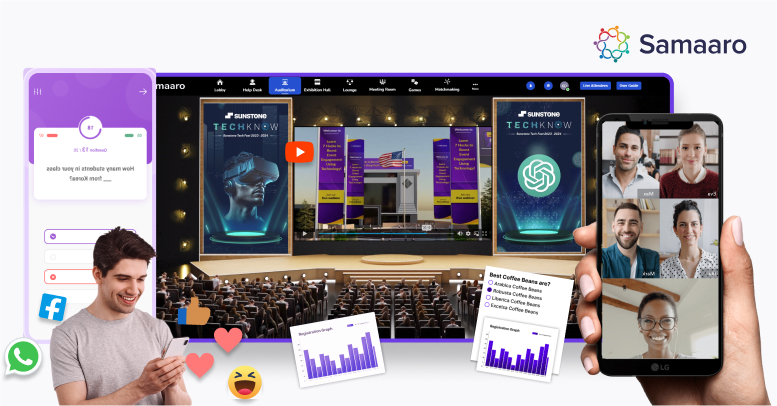
Event technology has revolutionized the way events are planned, executed, and experienced. It encompasses a wide range of digital tools and platforms that streamline event management processes and enhance attendee engagement. By integrating event technology, organizers automate gamified experiences, track progress, update leaderboards, and distribute rewards. This real-time engagement enhances attendee experience, fosters excitement, and provides valuable data for future events.
Now, once you have event technology for gamification, it is crucial to utilize it, which will effectively engage the audience. By leveraging the capabilities of event technology, you can design interactive and immersive game experiences that captivate and involve attendees. Let’s talk about some strategies for gamification in events.
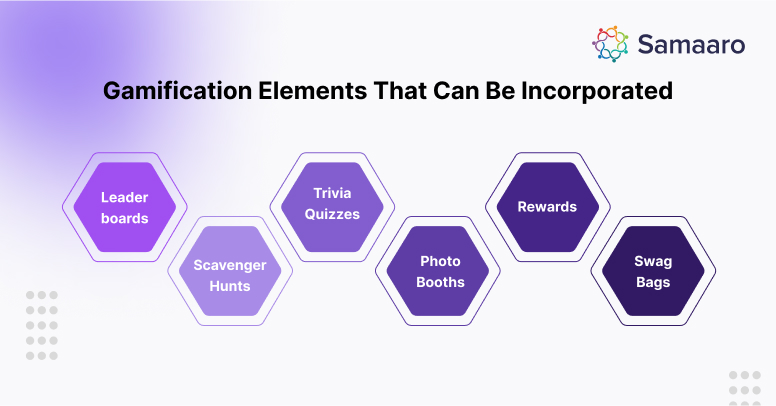
To effectively incorporate gamification into in-person events, it is crucial to establish clear objectives and goals. This involves determining what you want to achieve through gamification and how it aligns with the overall event objectives. For example, you might aim to increase attendee engagement, enhance networking opportunities, or encourage participation in sessions and activities. Let’s take a look at some Game Mechanics that you can incorporate in your event.
To make gamification engaging and enjoyable, it is important to design effective game mechanics and elements. Here are some examples:
Merely incorporating these elements is insufficient; utilizing them strategically in the appropriate areas will give you a competitive advantage in engaging audiences and generating leads.
Gamification can be integrated into various aspects of event planning to enhance the attendee experience. Consider the following strategies:
By incorporating gamification strategies into events, you can create an immersive and engaging experience that encourages attendee participation, fosters connections, and enhances overall event satisfaction.
To determine the impact and effectiveness of gamification strategies, it is important to explore relevant metrics and utilize appropriate tools. Consider the following approaches:
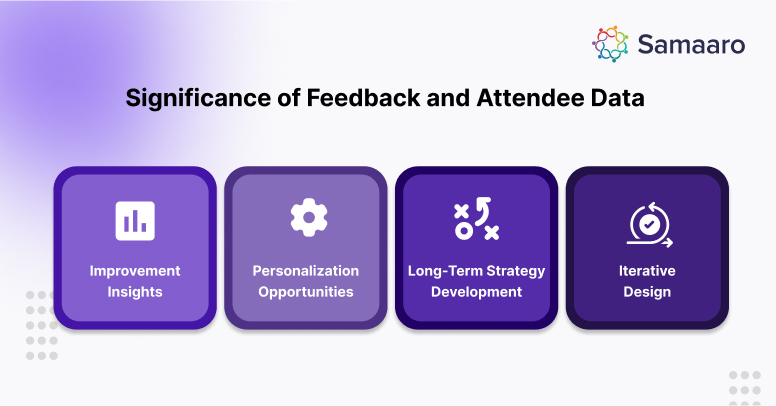
In conclusion, event organizers should embrace gamification as a powerful tool for creating memorable and interactive experiences at events. By leveraging event technology and designing effective game mechanics, organizers can foster engagement, enhance networking opportunities, and drive positive outcomes. With continuous evaluation, refinement, and utilization of attendee feedback and data, gamification can unlock the full potential of events, delivering valuable experiences that leave a lasting impact on attendees. For an event experience that delivers results, using an event technology is crucial, contact Samaaro today to explore how our event technology solutions can empower your gamification efforts and transform your next event into an immersive and engaging experience.
Hybrid events have become increasingly popular in recent years as organizations seek to leverage the benefits of both in-person and virtual events. Hybrid events allow for greater reach and audience engagement while also providing the opportunity for in-person networking and experiences.
The purpose of this guide is to provide you with a comprehensive understanding of what hybrid events are and how to plan and execute a successful hybrid event in 2023.

Hybrid events are events that combine both in-person and virtual experiences. This allows attendees to attend either in-person or virtually, providing greater flexibility and convenience.
A recent survey of event planners indicated that 86% of event organizers achieved a positive ROI from their hybrid event. Some advantages of hosting a hybrid event –
Overall, hybrid events can provide a range of benefits for both attendees and organizers. By combining the advantages of in-person and virtual events, they can provide a more engaging, cost-effective and flexible event experience.
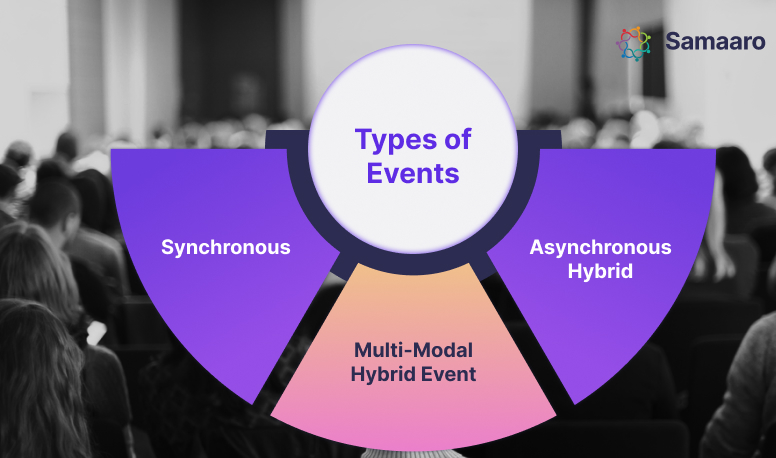
When it comes to hybrid events, there’s no one-size-fits-all approach. Event organizers need to carefully consider several factors, such as the type of event, audience, budget, and overall strategic purpose. Once the hybrid event model has been chosen, organizers must decide on the level of interactivity for virtual attendees. This will depend on the event’s objectives and the attendees’ preferences. There is no rule that hybrid events must be highly interactive; some events may focus on delivering information only. Conversely, hybrid events can be designed to be highly interactive, allowing virtual attendees to participate in group tasks, chats, and Q&A sessions. To make this possible, the event must be designed to minimize user obstacles and encourage engagement.
Synchronous Events: A synchronous hybrid event is a type of event that combines elements of both in-person and virtual events. Typically, this type of event allows both in-person attendees and virtual attendees to participate in the same event at the same time.
Some examples of events that can be classified as synchronous hybrid events include:

Overall, synchronous hybrid events are becoming increasingly popular as they offer the best of both worlds, allowing attendees to participate in events in the way that suits them best.
Asynchronous Hybrid Events: An asynchronous hybrid event is a type of event that combines elements of both in-person and virtual events, but unlike synchronous hybrid events, it does not require all participants to be present at the same time. Instead, participants can access event content and activities on their own schedule.
Some examples of events that can be classified as asynchronous hybrid events include:
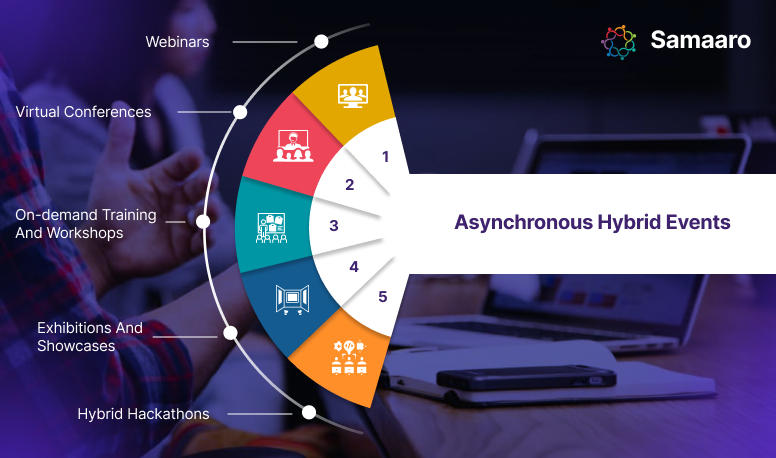
Overall, asynchronous hybrid events provide flexibility for participants who cannot attend events in real-time. They allow participants to access content and engage with event activities on their own schedule, making events more accessible and inclusive for a wider range of participants.
Multi-Modal Hybrid Event: A combination hybrid event, also known as a multi-modal hybrid event, is a type of event that combines both synchronous and asynchronous elements to create a unique and engaging experience for participants. In this type of event, attendees can choose how they participate based on their own needs and preferences, with a range of options available to suit different learning styles and schedules.
Some examples of events that can be classified as combination hybrid events include:
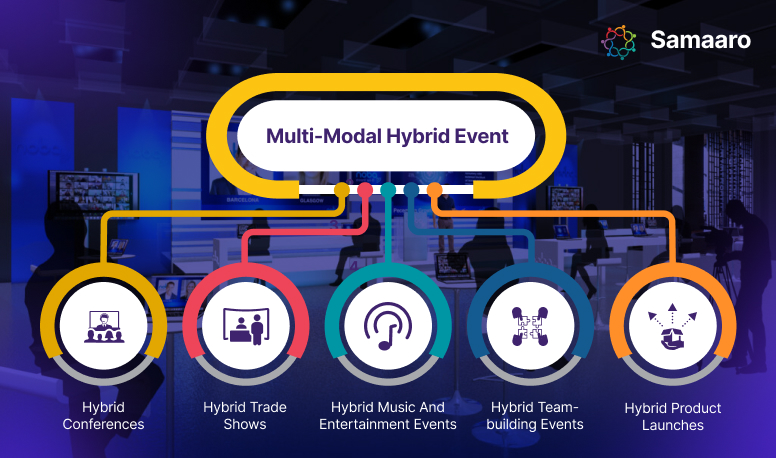
Overall, combination hybrid events offer a range of options for participants to engage with events based on their own preferences and needs. By combining both synchronous and asynchronous elements, these events can provide a more engaging and inclusive experience for all participants.

Planning a hybrid event comes with unique challenges, such as ensuring that the virtual audience is as engaged as the in-person audience. Below, is a step-by-step guide to help you plan and execute and understand the important parts of planning a hybrid event.
1. Setting Objectives and Defining Event Format
To plan a successful hybrid event, it is important to first define the goals and objectives of the event. Defining clear objectives is crucial for planning a successful hybrid event. Here are some questions that event planners should consider defining the objectives of their hybrid event:
Answering these questions can help define the objectives of the event and create a clear roadmap for planning and executing a successful hybrid event.
Being clear will help determine the event format that best aligns with your goals. For example, if your goal is to provide networking opportunities for attendees, you might choose a roundtable format. If your goal is to provide educational content, you might choose a conference format. It is important to consider the needs of both in-person and virtual attendees when deciding on the event format. Once the format is selected, plan sessions and activities that cater to both in-person and virtual audiences.
2. Time Zone & Event Venue
When planning a hybrid event, it is essential to consider the time zone of your target audience and the event venue. If you are hosting a global event, you may want to choose a venue that is easily accessible and has sufficient accommodation and transportation options. Virtual attendees should also be able to participate in the event regardless of their time zone.
To ensure that your event is accessible to all attendees, you may want to consider integrating live streaming and on-demand content. This allows attendees to participate in real-time or watch the event at their convenience.
3. Creating Personas (Identifying Target Audience)
Identifying your target audience is crucial to the success of your hybrid event. By creating personas, you will be able to understand the needs and preferences of your attendees and tailor the event to meet their expectations. Personas are fictional representations of your target audience and include their demographics, interests, behaviors, and pain points.
To create personas, you can conduct surveys, interviews, and focus groups to gather information about your target audience. This information can then be used to develop content, select speakers, and choose the right platform.
4. Defining Budget
Budgeting is an essential aspect of planning a hybrid event. It is crucial to determine the resources you will need and allocate funds accordingly. Your budget should include expenses such as venue rental, catering, audio-visual equipment, marketing, and staff.
To reduce costs, you may want to consider partnering with sponsors or exhibitors who can provide financial support in exchange for exposure. You can also consider using a hybrid event platform that offers a range of features at a lower cost than traditional event planning methods.
5. Choosing The Right Platform
Choosing the right platform is essential to the success of your hybrid event. The platform should provide a seamless experience for both in-person and virtual attendees and offer features such as live streaming, chat, and networking. It should also be user-friendly and customizable to meet your specific needs.
6. Building a team
Building a team is crucial to the success of your hybrid event. Your team should include individuals with a diverse range of skills and expertise, including event planning, marketing, technology, and customer service. Each team member should have a clear understanding of their roles and responsibilities and be able to work collaboratively towards the common goal.
7. Selecting The Right Speakers
Selecting the right speakers is crucial to the success of your hybrid event. Your speakers should be knowledgeable, engaging, and able to connect with both in-person and virtual attendees. They should also be able to deliver their message effectively through a range of mediums, including live streaming and on-demand content.
To select the right speakers, you can conduct research, seek recommendations, and review their past performances. You can also consider inviting industry experts or thought leaders who can provide valuable insights and perspectives on current trends and issues.
8. Partnering with Sponsors
Partnering with sponsors is an effective way to generate revenue and increase exposure for your hybrid event. Sponsors can provide financial support, products, or services in exchange for branding and advertising opportunities.
To attract sponsors, you should create a sponsorship prospectus that outlines the benefits and opportunities available to sponsors. You should also identify potential sponsors who align with your event objectives and target audience.
9. Event Agenda
Creating a compelling event agenda is essential to the success of your hybrid event. Your agenda should include a mix of keynote speakers, breakout sessions, networking opportunities, and activities that cater to both in-person and virtual attendees.
To create an effective agenda, you should consider the needs and preferences of your target audience and ensure that the content is relevant and engaging. You can also leverage technology to provide interactive and immersive experiences for attendees.
In today’s digital age, hybrid events have become the norm to bring together both in-person and virtual attendees. But to create a successful and seamless event, event planners must utilize innovative solutions that can seamlessly connect audiences from different locations. This is where event technology plays a crucial role. Pre-event technology, in-event technology, and post-event technology are all essential for a successful and result-driven hybrid event. Listed down are the different types of event technology that can enhance the hybrid event experience, including best practices for using event technology to ensure a successful event.

Before a hybrid event can take place, there are several important pre-event technologies that event planners should consider as the event will be catering to a plethora of audiences, in virtual and physical settings.
In-event technology refers to the technologies used to create a seamless and engaging experience for both in-person and virtual attendees. These technologies can include analytics, live streaming, virtual event platforms, mobile event apps, tech for sponsors and exhibitors, digital signage, and A/V equipment. They are used to enhance the attendee experience, facilitate interactions between in-person and virtual attendees, and ensure that both groups feel included and engaged throughout the event.
In the context of post-event technology for hybrid events, there are several important tools and strategies that can be employed. These technologies focus on maximizing the value and impact of the event even after it has concluded. Here are some key post-event technologies for hybrid events:
In summary, the aforementioned technologies encompassing pre-event, in-event, and post-event capabilities can be integrated into a comprehensive, all-in-one event technology platform. Samaaro is a prime example of such a platform, designed to cater to the diverse needs of event professionals hosting various types of hybrid events. By leveraging Samaaro, event organizers can access a unified solution that streamlines event management, enhances attendee engagement, facilitates virtual components, captures valuable data, and supports seamless execution of hybrid events. With Samaaro’s comprehensive features and capabilities, event professionals can optimize their event planning and delivery, ensuring a successful and impactful experience for both in-person and virtual attendees.
Hybrid events offer a unique opportunity to create engaging experiences by combining the best of virtual and in-person elements. Here are some tips to design captivating virtual experiences and in-person experiences, as well as foster seamless integration between the two:
Creating seamless integration between in-person and virtual experiences is crucial for a cohesive hybrid event. However, it’s important to recognize that treating in-person and virtual attendees equally and expecting them to interact during the event may not be the most effective approach. Instead, understanding the unique needs and preferences of each group and delivering tailored experiences is key.
By implementing these tips, event organizers can design engaging virtual experiences, create immersive in-person environments, and seamlessly integrate the two, ensuring a cohesive and captivating hybrid event experience for all participants.
Marketing and promoting your hybrid event are crucial for its success. A well-executed marketing plan can attract both in-person and virtual attendees, generate excitement, and maximize participation. In this section, we will explore the key components of marketing your hybrid event effectively.
To create a comprehensive marketing plan for your hybrid event, consider the following steps:
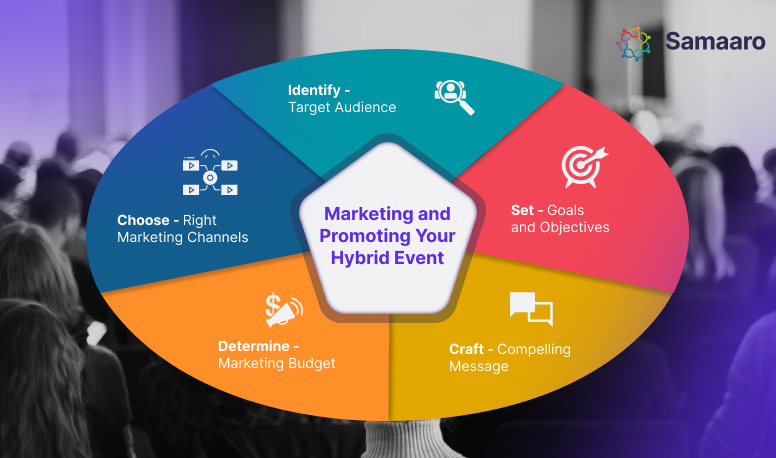
To effectively promote your hybrid event, consider the following platforms:

Creating anticipation before your hybrid event can generate excitement and boost attendance. Implement the following strategies:
Executing a hybrid event requires careful planning and coordination to ensure a seamless experience for both in-person and virtual attendees. In this section, we will explore the key aspects of executing a successful hybrid event.
When managing the on-site logistics of your hybrid event, consider the following factors:
To effectively manage the virtual component of your hybrid event, consider the following aspects:
Despite careful planning, technical difficulties may still arise during a hybrid event. Prepare for such situations by implementing the following strategies:
By effectively managing on-site logistics, hybrid platforms, and technical difficulties, you can ensure a successful and engaging hybrid event for all attendees.
The end of one event marks the beginning of the next, and it’s important to maintain a connection with attendees. After the conclusion of a hybrid event, it is essential to engage in post-event activities that not only evaluate the event’s success but also set the stage for future improvements. Here are three crucial post-event activities to consider: follow-up communication and engagement, measuring success and evaluating performance, and improving future hybrid events.



By focusing on follow-up communication and engagement, measuring success and evaluating performance, and continuously improving future hybrid events, organizers can ensure that each event becomes better than the last, providing enhanced experiences and value to attendees, sponsors, and stakeholders.
Hybrid events have emerged as a powerful and dynamic format that combines the best of both virtual and in-person experiences. This section provides a recap of key takeaways, explores the future outlook for hybrid events, and offers final thoughts and recommendations.
Throughout this guide, we have explored various aspects of planning, executing, and maximizing the potential of hybrid events. Key takeaways include:

The outlook for hybrid events is promising, as they continue to gain popularity and evolve in response to changing circumstances and technological advancements. Here are a few predicted key points regarding the future of hybrid events:
As hybrid events become increasingly prevalent, it is crucial for organizers to adapt and evolve. Here are some final thoughts and recommendations:
By implementing these recommendations and staying attuned to industry trends, organizers can unlock the full potential of hybrid events and deliver outstanding experiences for attendees, sponsors, and stakeholders.
In conclusion, Hybrid events hold immense potential to reshape the event industry and provide unparalleled experiences for attendees. To unlock the full capabilities of hybrid events and seamlessly manage the virtual and in-person aspects, consider leveraging advanced event management platforms like Samaaro. Samaaro offers a comprehensive suite of tools and features to streamline event planning, enhance engagement, and provide a seamless experience for both virtual and in-person participants. Take the next step towards revolutionizing your hybrid events by exploring Samaaro and schedule a demo. Together, let’s create extraordinary hybrid event experiences that leave a lasting impact.
Event registration and ticketing are not merely administrative processes but integral components of creating exceptional event experiences. The way organizers communicate, streamline the registration process, engage attendees, and leverage data can significantly impact the overall success and satisfaction of an event. In fact, “a survey conducted among event marketers revealed that 49% of them see participant engagement as the most important factor for a successful event”. In this article, we will explore various aspects of event registration and ticketing software that contribute to crafting memorable experiences for both organizers and attendees.
Note – This article is broken down in 3 parts to explain the Use of Event Registration and Ticketing Software.
A successful event begins well before attendees arrive at the venue. Pre-event communication plays a crucial role in setting expectations, conveying important information, and creating a personalized experience for participants. By leveraging the power of event registration and ticketing software, organizers can go beyond the basics and maximize event experiences right from the start.
Below are some ways in which organizers can start enhancing the event experience through ticketing and registration software.
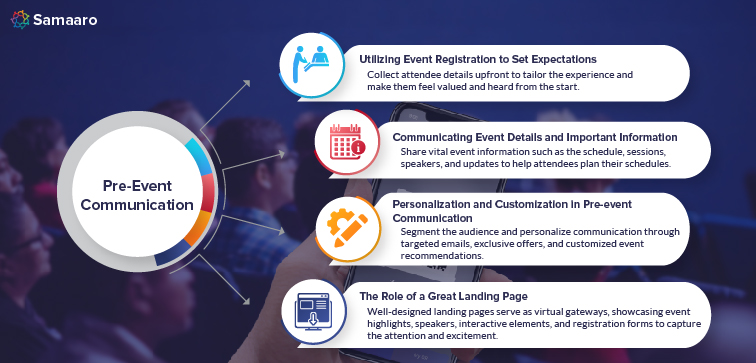
Once the essential aspects of pre-event communication have been established it is important to move on to creating a seamless registration process.
A seamless registration process is key to maximizing event participation and ensuring a positive attendee experience. In this section, we will explore various elements that contribute to a smooth registration process, from user-friendly forms and interfaces to integrating registration with CRM and marketing tools. Let’s dive in!
(Use Full Tip: Clear instructions, minimal fields, and logical flow contribute to a seamless experience, increasing the likelihood of successful registrations.)
A seamless registration process sets the stage for enhancing attendee engagement during an event. When attendees experience a smooth and hassle-free registration, they are more likely to approach the event with a positive mindset and enthusiasm.
Engaged attendees are at the heart of any successful event. Creating meaningful interactions and fostering a sense of connection contribute to a memorable attendee experience. From customizing confirmation emails and tickets to providing event updates and reminders, organizers can keep attendees informed and excited. Leveraging social media and online communities further amplifies engagement by creating a platform for interaction and networking. Additionally, promoting referrals and social sharing by attendees generates buzz and expands the event’s reach.
The image below explores the diverse avenues of enhancing attendee engagement and how it can lead to an immersive and rewarding event experience.
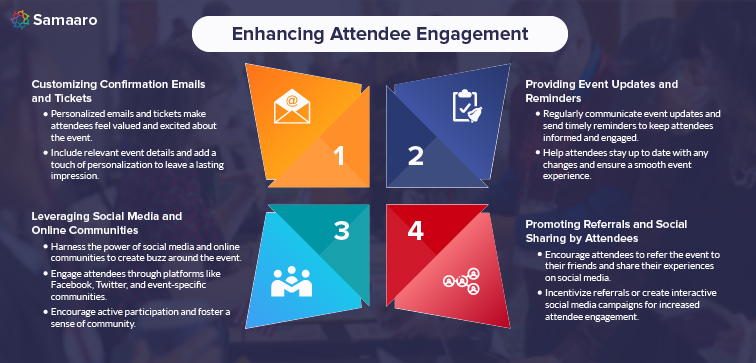
Delivering personalized experiences is a hallmark of exceptional events. By understanding attendees’ preferences and catering to their unique needs, organizers can create an unforgettable journey for each participant. Here are key strategies to provide customized experiences:
By paying attention to these small details, organizers can create tailored experiences by incorporating Ticketing and Registration in the event. Another crucial aspect of enhancing attendee engagement during an event is to focus on the on-site check-in experience.
Efficient check-in is essential to ensure attendee satisfaction and create a positive first impression. From streamlining the process to utilizing technology for fast and efficient check-ins, organizers can minimize wait times and enhance attendee satisfaction. By prioritizing these aspects, attendees can swiftly enter the event and immerse themselves in the activities without any unnecessary delays.
Below given are some key strategies to optimize the check-in process:
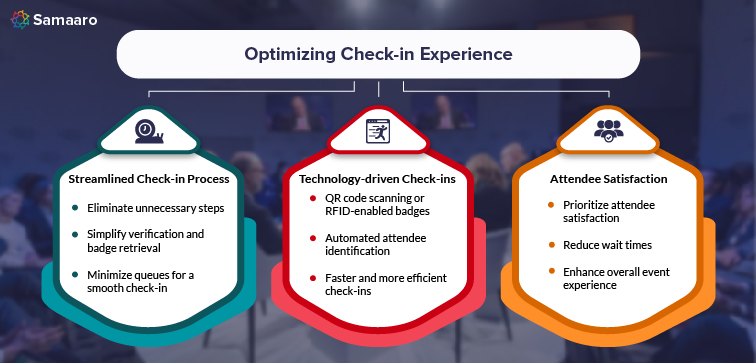
Efficient check-in is essential to ensure attendee satisfaction and create a positive first impression. However, the attendee engagement doesn’t end with the on-site check-in experience. Now, comes the last but an equally important step – Post Event use of Event Ticketing and Registration Software.
Even after the event concludes, the journey with attendees continues. Post-event follow-up and engagement play a crucial role in nurturing relationships and creating a lasting impact. In this section, we explore key strategies to keep attendees engaged and maintain their enthusiasm beyond the event itself. From expressing gratitude to gathering feedback and offering exclusive benefits, these practices contribute to a memorable post-event experience and set the stage for future interactions. Let’s delve into the essential elements of post-event follow-up and engagement to maximize attendee satisfaction and build a strong community around your events.
Wait! It does not end at post event follow up and engagement, through the vast amount of data collected by following all the above given parts, you now have an ocean of data to make your next event a huge success.
In today’s data-driven world, organizations have access to vast amounts of information that can be harnessed to drive continuous improvement. This is particularly relevant in the context of event management, where data analysis can provide valuable insights into registration and ticketing processes, enabling organizers to identify areas for improvement and make data-driven decisions for future events.
Some ways of leveraging this data :
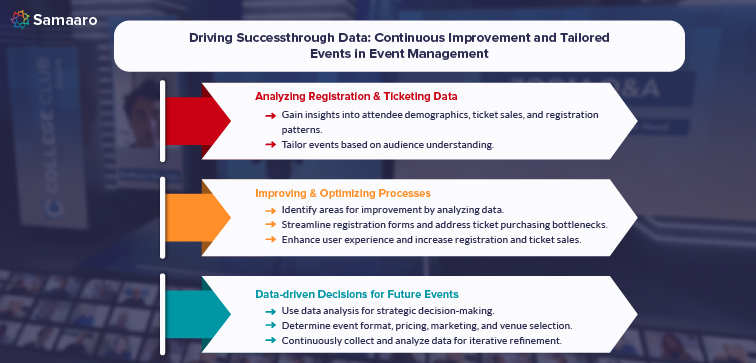
In conclusion, event registration and ticketing play a vital role in creating exceptional event experiences. From pre-event communication to on-site check-in, attendee engagement, and post-event follow-up, each aspect contributes to the overall success and satisfaction of an event. By leveraging the power of data and incorporating effective strategies, event organizers can continuously improve their processes, tailor events to audience preferences, and drive greater overall success.
To achieve these goals, Samaaro’s Ticketing and Registration Solution offers a comprehensive platform that streamlines the entire event management process. With Samaaro, you can effortlessly handle event registration, enhance attendee engagement, optimize the check-in experience, and gather valuable data for continuous improvement. Samaaro’s user-friendly interface, personalized communication options, and seamless integration with CRM and marketing tools provide organizers with the tools they need to create memorable event experiences.
Don’t settle for average events. Choose Samaaro’s Ticketing and Registration Solution and unlock the full potential of your events. Drive success, tailor experiences, and create unforgettable memories. Start using Samaaro today and take your event management to new heights.
Sponsors have always been an integral part of event planning, playing a critical role in supporting and enriching events. Sponsors serve a significant part in the success of events, and their engagement extends far beyond financial assistance. They provide knowledge, industry insights, and essential resources to the event, which improves the overall event experience for attendees. Sponsors demonstrate their dedication to community participation, brand loyalty, and corporate social responsibility by investing in events. Sponsors, in essence, serve as the events’ backbone, encouraging their growth, influence, and long-term viability.
But in return, we need to understand their objectives from participating in the event. It could be to generate leads; it could be to create brand awareness or may be just part of their CSR. Nevertheless, they expect a return on their investment. What if we told you there’s a way to increase the value of your sponsors even more? Event organisers may create tactics that not only benefit sponsors but also improve the entire event experience for attendees by recognising the importance of sponsors and their aims.
Let’s explore some strategies in detail, ensuring that sponsors can maximize their participation and achieve their desired outcomes in hybrid events.
1. Hosting Hybrid Events
Hybrid events, increases the impact of your events and opens new opportunities for sponsors. Why simply hold traditional in-person events; when you can use the potential of hybrid events to increase sponsor ROI, broaden reach, and create amazing moments for every individual involved. Don’t believe us, here’s a recent report that shows, “50.7% of event marketers surveyed believe that all live events in the future will include some form of digital components.”
2. Give Sponsors Their Own Digital Footprint
Brochures and catalogues are no longer satisfactory for captivating attendees. Provide sponsors with their own digital presence to ensure they stand out. Within the event platform, create a dedicated sponsor page or microsite that includes a visually appealing product gallery, a resource centre, and engaging material. This approach will assist sponsors in efficiently showcasing their products, increasing brand awareness, and encouraging consumers to connect with their information.
3. Implement Multiple Lead Capturing Alternatives
By providing a variety of lead capturing options, sponsors will be able to interact with potential prospects more efficiently. On the sponsor page, provide choices such as a meeting calendar, a “enquire now” button, or a “get in touch with the team” function. By providing different touchpoints, attendees may interact with sponsors in a way that meets their interests, resulting in increased lead generation.
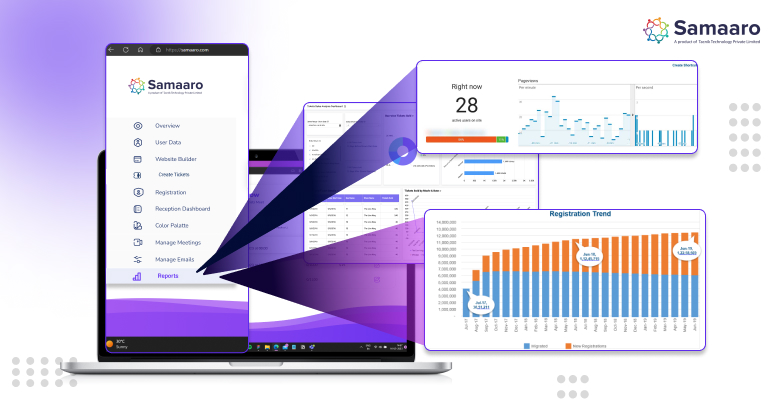
4. Gamify Lead Capturing
By gamifying the process, you can turn lead generation into an engaging experience. Instead of just putting business cards into a bowl, try scanning business cards or scanning QR codes to collect leads. Visitors who attend the event and scan QR codes at booths get points, and the top 100 participants are qualified to win prizes. This approach provides organisers with useful information such as popular booths and the average number of visitors to the exhibition halls. It also aids exhibitors in generating leads. This gamification feature will not only make lead generation more pleasant, but it will also inspire attendees to interact with sponsors.
5. Use AI Match-Making for Product Discovery
Use AI matchmaking to improve the attendance experience and drive more leads to sponsors. Create a product discovery tool that offers suitable products based on the interests and preferences of participants. Attendees are more inclined to investigate sponsor products that correspond with their needs when personalised suggestions are made, resulting in greater lead conversion rates. Further, attendees should also be able to search for products while applying necessary filters.
6. Pre-Event Meeting calendar
Before the event, set up a pre-event meeting calendar to allow participants to book meetings with sponsors ahead of time. Send out personalised “Book a Meeting” invitations through email or send engaging push notification that attract the audience, allowing attendees to reserve time slots with potential sponsors. This proactive strategy guarantees that sponsors spend one-on-one time with potential leads, resulting in more meaningful interactions and improved lead conversion rates.
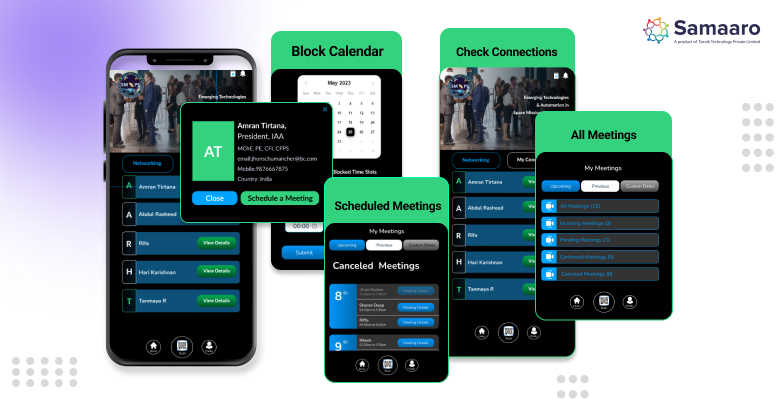
Remember that the relationships established, and the value created are at the heart of every successful hybrid event. By allowing sponsors to shine and engage guests in unconventional ways, you will generate a buzz that will last long after the event has ended. Attendees will recall the unique experiences and conversations, sponsors will value the leads and exposure, and your event’s status as a go-to industry meeting will be cemented.
So, include these ideas into your next hybrid event with Samaaro’s holistic solutions. Accept the endless potential of fusing the physical and virtual worlds, and watch as sponsors grow, attendees connect, and your event climb to new heights. Let’s work together to generate more leads, leave a lasting impression, and carve a successful route in the ever-changing world of hybrid events.
“80% of B2B customers make decisions based on the experience they have with each other. This is a clear indicator of how important networking can be for business.”
Networking is essential at every event, whether it is a conference, trade exhibition, or corporate gathering. It fosters exchanges of knowledge and the discovery of prospective business opportunities by facilitating connections among attendees. It is vital to give abundant networking opportunities in addition to creating an immersive event experience with modern technology, captivating exhibits, and recognised keynote speakers.
While participants may go home with prizes and instructional guides, the key to having a memorable and talked-about event is to provide compelling networking opportunities. Fortunately, the development of innovative technologies has greatly benefited event planners in making networking opportunities more accessible, convenient, and efficient, consequently connecting like-minded participants throughout the event lifetime.
In this blog we will delve into the benefits of networking at any event and have a look at some of the features that make the networking aspect in events smooth.
Expand your professional network: Networking allows you to broaden your professional circle, boosting your chances of discovering new employment prospects, partnerships, and possible clients. It allows you to access a larger pool of resources, knowledge, and skills.
Build relationships and enable collaborations: Events provide a platform for networking with peers in the field, potential mentors, and thought leaders. These connections can lead to collaborations, joint ventures, and useful insights that can help you advance in your profession or business.
Enhance personal and professional growth: Attending events with diverse professionals exposes you to new perspectives, ideas, and experiences. This exposure promotes personal and professional development by extending vistas and questioning assumptions.
Keep up with industry trends: Certain events frequently draw industry experts and thought leaders who share valuable insights and knowledge. Attending these events allows you to stay abreast of the latest trends, emerging technologies, and industry best practices.
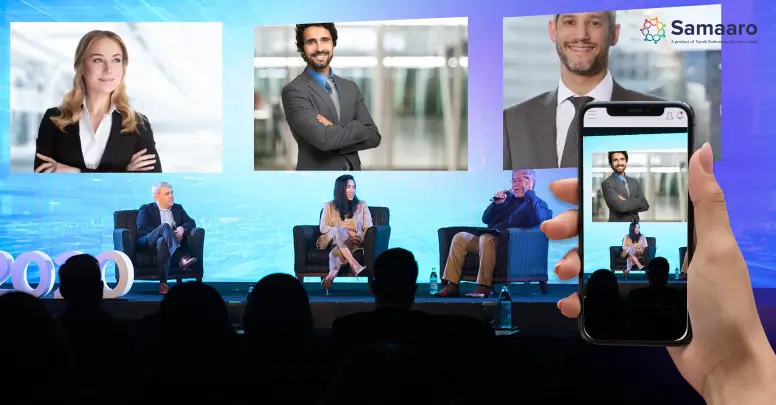
Matchmaking: Our matchmaking feature updates matches in real-time based on users’ previous connections and shared interests. For example, if you’re interested in machine learning, you’ll be shown a list of people who share that interest. Once you connect with individuals who are also marketers, the algorithm starts suggesting people who are interested in machine learning and are also marketers. This real-time updating ensures that you’re presented with more relevant connections, increasing the likelihood of finding meaningful matches.
Breakout Rooms: Breakout rooms allow for smaller, more concentrated talks among people who have common interests. Samaaro incorporates a breakout room feature, which allows attendees to join specific topic-based discussions. Event organizers can create and moderate these rooms, ensuring a conducive environment for networking and knowledge exchange.
Meeting Scheduler: Efficient scheduling is vital for maximizing networking opportunities. Build an easy-to-use meeting scheduler that allows attendees to schedule one-on-one meetings with other attendees. This feature is particularly useful in the pre-event phase, as it empowers users to plan their calendar effectively. Attendees can view the availability of other participants and identify potential time slots that align with their own schedule. Users can see each other’s availability and send meeting requests, which eliminates the need for back-and-forth communication and speeds up the networking process.
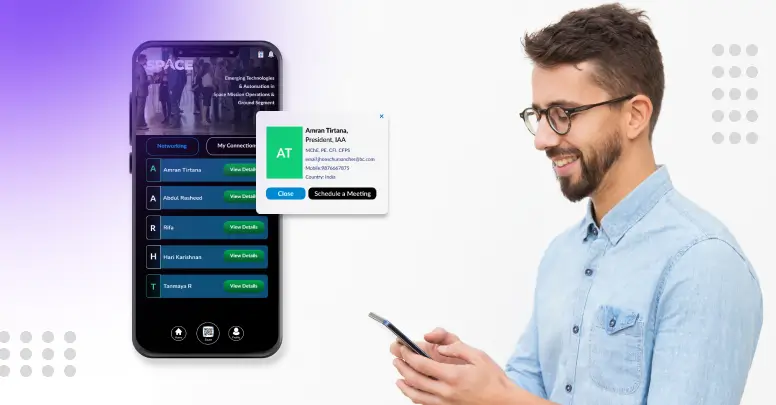
Business Card Exchange: The days of worrying about losing business cards are long gone. In a digital age, exchanging physical business cards may seem outdated. Instead, you can include a digital business card exchange feature that allows attendees to easily share their contact information. Users can scan one other’s QR codes or share information directly through the app, ensuring convenient and efficient information sharing.
Attendee Chat & Video Call: The inclusion of a chat and video call function within the event platform enhances networking by enabling real-time communication. This feature proves valuable before and after the event, allowing participants to connect and converse seamlessly. Prior to the event, it facilitates introductions, idea exchange, and relationship building. During the event, it enables immediate interactions, question asking, and deeper connections through face-to-face video calls. Post-event, it serves as a communication channel for ongoing engagement, resource sharing, and collaboration. Overall, this feature adds convenience, personalization, and effectiveness to networking experiences, fostering meaningful connections.
Group Activities and Games: Networking can go beyond the conventional formats. To foster engagement and collaboration, incorporate group activities and games. Attendees can take part in team competitions, virtual scavenger hunts, or icebreaker games, providing a fun and engaging environment that allows for comfortable networking and is a great icebreaker between attendees.
In conclusion, the value of networking during events cannot be emphasised. It acts as a catalyst for professional development, personal development, and the establishment of important connections that can have a tremendous impact on our lives. Individuals can manage events with confidence, establish discussions with ease, and build relationships that extend beyond the event itself by applying the approaches mentioned in this post. Networking, whether at a conference, seminar, or industry event, provides excellent opportunity to learn, collaborate, and create new possibilities. So, embrace the power of networking, get out of your comfort zone, and you’ll discover a world of limitless possibilities just waiting to be discovered. Always keep in mind that every connection you make can affect your future, both personally and professionally.
Sponsorship management plays a vital role in the success of any event. Sponsors not only provide financial support but also contribute to the overall experience and value offered to attendees. However, managing sponsorships effectively can be a daunting task for event organizers. The complexity of identifying suitable sponsors, negotiating agreements, and ensuring fulfillment of sponsorship obligations can often lead to challenges and inefficiencies. This is where event management software come into play.
Best event management softwares are designed to streamline and optimize various aspects of event planning and execution. These solutions offer a range of features and functionalities specifically tailored to enhance sponsorship management.
In the following sections, we will delve deeper into the role of event management software in enhancing sponsorship management. We will explore the specific challenges faced by event organizers, how event management software addresses those challenges, and the various features and functionalities that contribute to streamlining sponsorship management processes.
Sponsorship management encompasses several key elements that are crucial for successful collaboration between event organizers and sponsors. These elements include:



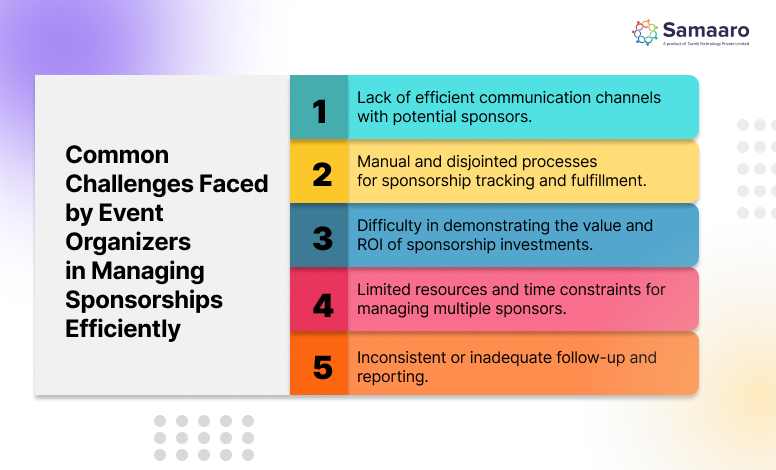
By leveraging event management software, event organizers can overcome these challenges and optimize sponsorship management processes. These solutions provide centralized platforms that streamline sponsor identification, negotiation, fulfillment, and tracking. This ultimately leads to improved sponsor relationships, increased revenue, and enhanced event experiences.
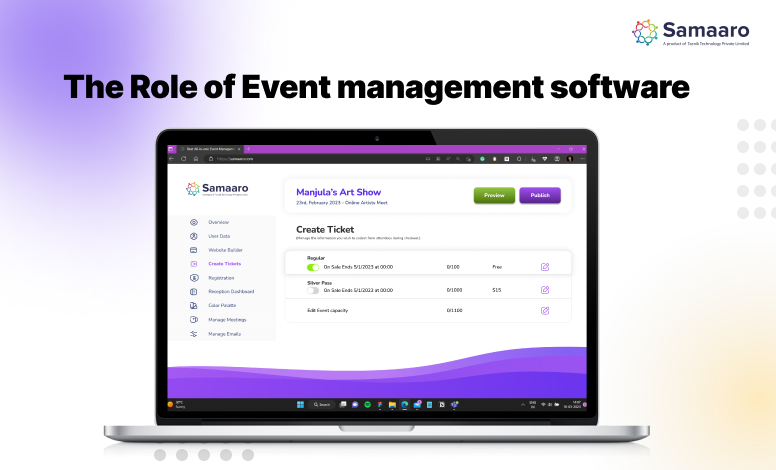
Event management software are comprehensive software platforms designed to simplify and optimize various aspects of event planning and execution. These solutions play a crucial role in enhancing sponsorship management by providing specialized features and functionalities tailored to streamline the sponsor-related processes. Some of the features include:
Event management software play a vital role in enhancing sponsorship management by providing efficient tools, automation, and streamlined processes. These solutions empower event organizers to optimize sponsorship acquisition, negotiation, fulfillment, and reporting, ultimately strengthening sponsor relationships and maximizing the impact of sponsored events.
Event management software play a vital role in fostering effective communication and engagement between event organizers and sponsors. These solutions offer various features that facilitate seamless collaboration and provide valuable insights for tracking ROI.
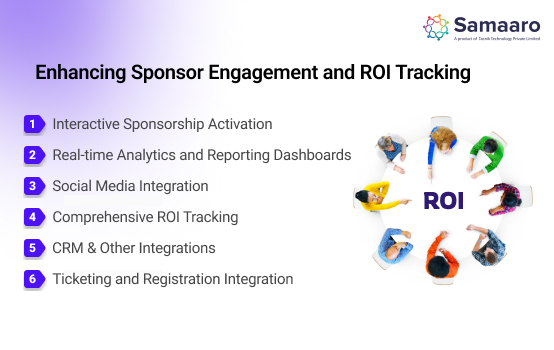
Event management software streamline sponsorship management, providing centralized platforms for simplified planning, enhanced communication, and comprehensive tracking. These solutions optimize sponsorship acquisition, negotiation, fulfillment, and reporting, fostering stronger sponsor relationships and maximizing event impact. Samaaro’s event management software streamlines sponsorship management by simplifying event planning, enhancing communication, and providing comprehensive tracking. Samaaro’s solution also enables immersive experiences, real-time analytics, social media integration, and ROI tracking, fostering strong sponsor engagement and maximizing event impact. Ultimately, Samaaro’s event management software ensures effective sponsorship management and contributes to successful events.
According to recent statistics, “Event marketing is considered the most effective marketing channel by approximately 31% of B2B marketers.” It is a highly valuable strategy that benefits various types of businesses, including technology, education, non-profit organizations, medicine, and retail.
In another study, it was found that “52% of marketers believe event marketing generates the best return on investment”. Additionally, it promotes product and industry expertise while also improving brand awareness, among other benefits.
Now that we’ve established the significance of event marketing, to maximize the impact and reach of an event, it is crucial to develop a comprehensive marketing strategy that covers the pre-event, post-event, and during event phases.
Establish goals: Determine your objectives for the event. Are you trying to enhance revenue, brand recognition, or lead generation? Your marketing activities will be driven by clearly defined targets, and you can track your progress with them.
Develop captivating content: It raises anticipation for the event and conveys its value. This can be done through emails, videos, teasers on social media, and blog articles. Use narrative strategies to attract your audience and give them a glimpse of things to come.
Utilise social media: Social media platforms are effective resources for event marketing. Make event-specific hashtags, reveal behind-the-scenes shots, and drive attendees to tell others about it. Run competitions, polls, and Q&A sessions to interact with your audience and create excitement.
In this blog, we’ll look at a few event marketing strategies that can help you boost interest, improve attendance, and engage your audience. Let’s take a look at the numerous possibilities, which range from developing an attractive landing page to using social media advertising.
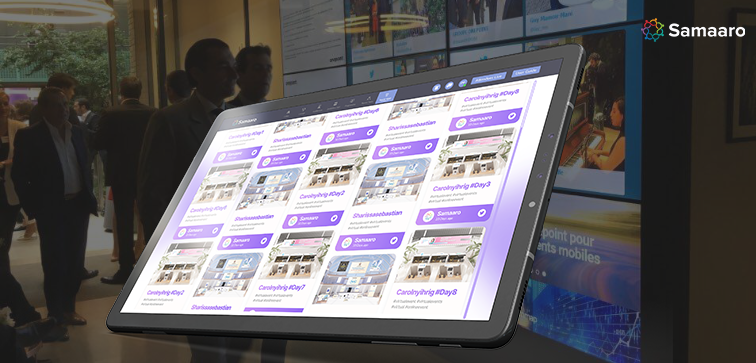
Engage Participants with Interactive Experiences: Make the event as a captivating and unforgettable one. Use interactive components to keep guests interested and promote meaningful interactions, such as live polls, Q&A sessions, and gamification. Encourage social sharing by setting up Instagrammable moments and photo booths.
Utilise Live Streaming and Online Attendance: In the era of hybrid events, employ live streaming to broaden the audience for your event. Encourage online involvement by using hashtags and engaging live chats. Give distant participants access to premium virtual content to make them feel included.
Promote User-Generated Content: Encourage participants to use the hashtags associated with the event to post about their experiences on social media. UGC not only expands the audience for your event but also acts as real testimonies. Consider running contests or offering incentives for the best UGC submissions.
Recap and Share the Highlights: After the event, upload blog posts, videos, and social media updates to share the highlights, key points learned, and unforgettable moments. This extends the duration of the event and enables others who missed it to catch up.
Follow Up with Participants: Both physically and virtually, by sending them personalised emails or messages. To maintain the relationship and nurture leads obtained during the event, offer extra resources, special discounts, or invitations to subsequent events.
Leverage User-Generated Content: Keep showcasing user-generated content that was produced during the event. This not only recognises the contributions of the participants but also promotes a sense of community and encourages further participation.
Requesting Testimonials and Feedback: Send out surveys to participants to get feedback and testimonials. This feedback can help you improve future events and provide valuable insights for your marketing efforts. Testimonials can be used in promotional materials or shared on social media to build credibility.
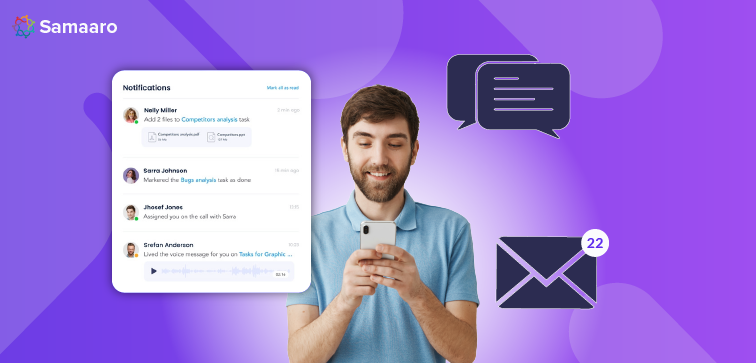
Start with a captivating Event Landing Page
Creating an aesthetically devoted landing page for your event is a simple yet extremely successful method. This landing page is a significant tool since it captures the information of those who are interested in attending your event, resulting in many registrations.
Samaaro assures the availability of a wide range of templates that suit the topic of your event. Furthermore, Samaaro assists in embracing inclusion and engaging a completely new population, hence increasing your reach and effect through SEO-optimized content.
To create a landing page that efficiently converts visitors into attendees, the following things must be included:
Build an Email Marketing Campaign
Email marketing is frequently considered one of the most effective methods of event marketing. Event organizers frequently utilize it to effectively interact with their target audience. Using email marketing, you may build a relationship with potential attendees throughout the registration process and nurture them until the event day. This method takes two tactics: sending informative emails to tell registrants about event specifics, or sending entertaining emails to increase excitement as the event approaches. Try using an appealing subject line that catches users’ attention. A simple headline such as “You don’t want to miss out” goes a long way and creates ample buzz.
Engage attendees in events with 360 notifications
Increase engagement potential by using push notifications, regardless of what sort of event you’re planning—in-person, online, or hybrid—it’s crucial to recognise that participants frequently have busy schedules and may find it difficult to remember every session or piece of information they meant to take in. While giving each attendee their own customised event schedule can be useful, it’s also crucial to implement push notifications via email or a mobile event app to remind them when sessions start and to encourage them to participate in wellness or gamification activities that are provided outside of sessions.
Build momentum on social media
Social media above all things is a great way to make noise about the event. Today, where more than 3.8 billion people are active on various social networks, it makes sense to promote your event across several channels where your target audience is present. There are various ways to use social media to promote an event. You may use Instagram to publish captivating videos or reels, build Facebook pages devoted to your event, use a unique hashtag for your content, and use separate marketing strategies to reach people across numerous platforms. To generate content, the world is shifting to AI models, so why should you wait. You may also cooperate with event co-hosts and speakers to cross-promote and expand your reach. Furthermore, social media offers a wide range of tools that may be used to promote your event.
Swag Bags
Lastly, consider collaborating with branded swag suppliers to boost your brand and offer complimentary gifts to your event participants, because let’s be honest, everyone appreciates freebies. When it comes to designing outstanding gift bags, the options are basically limitless. The secret is to offer a sizable variety of freebies and branded things all at once, whether you use plastic bags, tote bags, or think outside the box with unconventional containers like baskets, bowls, or crates! Who can resist the charm of receiving a high-quality branded mug or koozie?

Built for modern marketing teams, Samaaro’s AI-powered event-tech platform helps you run events more efficiently, reduce manual work, engage attendees, capture qualified leads and gain real-time visibility into your events’ performance.


© 2025 — Samaaro. All Rights Reserved.